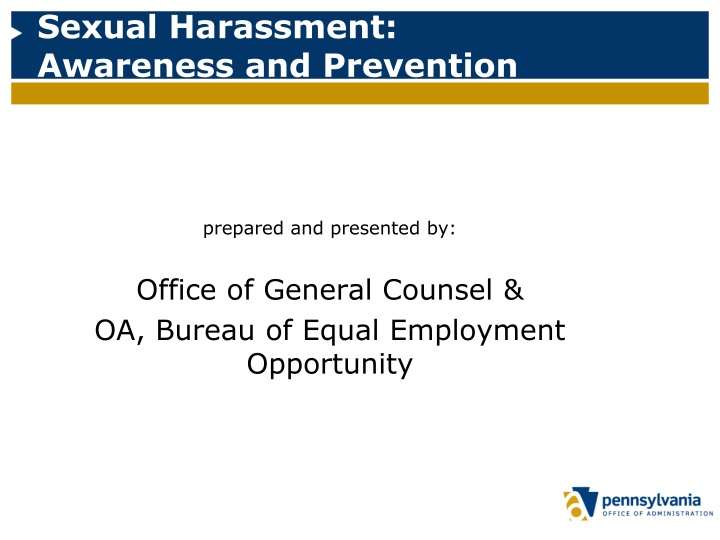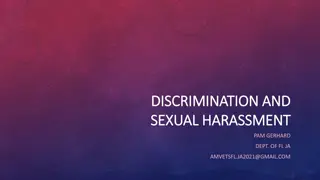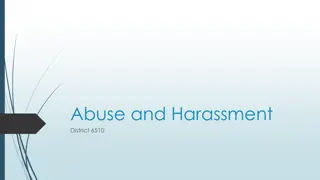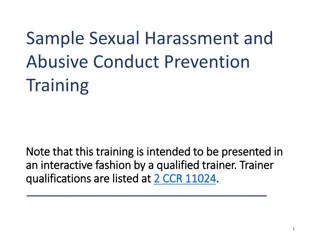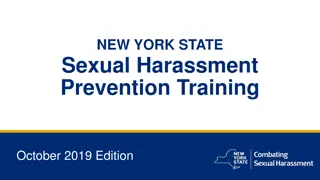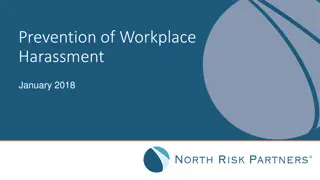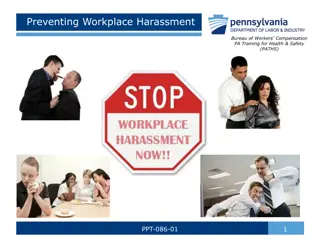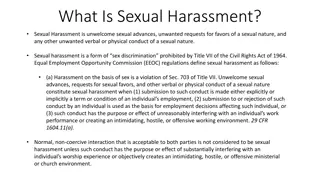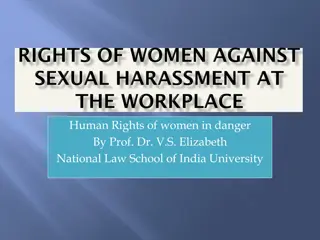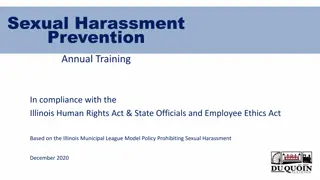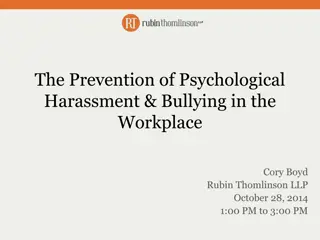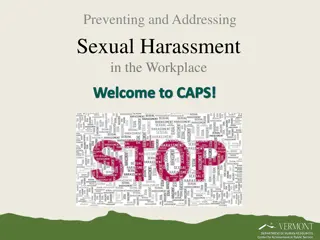Sexual Harassment Awareness and Prevention Training Session
Gain knowledge on sexual harassment definitions, types, workplace behaviors, reporting procedures, prevention strategies, and the importance of Commonwealth policies. Understand why both the employer and employees should be concerned about sexual harassment. Engage in interactive sessions, surveys, and discussions to enhance awareness and prevention efforts.
Download Presentation

Please find below an Image/Link to download the presentation.
The content on the website is provided AS IS for your information and personal use only. It may not be sold, licensed, or shared on other websites without obtaining consent from the author.If you encounter any issues during the download, it is possible that the publisher has removed the file from their server.
You are allowed to download the files provided on this website for personal or commercial use, subject to the condition that they are used lawfully. All files are the property of their respective owners.
The content on the website is provided AS IS for your information and personal use only. It may not be sold, licensed, or shared on other websites without obtaining consent from the author.
E N D
Presentation Transcript
Sexual Harassment: Awareness and Prevention prepared and presented by: Office of General Counsel & OA, Bureau of Equal Employment Opportunity
Agenda Introduction and Objectives Survey Definition of Sexual Harassment Video Vignettes Commonwealth Policy Reporting Procedure Summary 2
Course Objectives After completing this session, you will be able to: Define sexual harassment. Identify the types of sexual harassment. Identify behaviors that may be interpreted as sexual harassment in the workplace. Apply commonwealth policy that prohibits sexual harassment and retaliation.
Course Objectives After completing this session, you will be able to: Report sexual harassment pursuant to commonwealth policy. Identify strategies to prevent sexual harassment.
Why? Why would the commonwealth, as your employer, be concerned about sexual harassment? Why would you, as an employee, be concerned?
Pre-Training Survey Please take a few minutes and complete the Pre-Training Survey What Do I Know About Sexual Harassment found in your handouts . . .
What Do You Know? True or False? 1. Sexual harassment in the workplace is a form of workplace discrimination. TRUE.
What Do You? True or False? 2. Sexual harassment is a violation of state and federal laws. TRUE. Sexual harassment is a violation of state law (PHRA) and federal law (Title VII).
What Do You? True or False? 3. The commonwealth has a policy prohibiting sexual harassment that includes procedures on how to report harassment. TRUE.
What Do You? The commonwealth s policy on sexual harassment is found in: Executive Order 2002-4 Prohibition of Sexual Harassment in the Commonwealth Management Directive 505.30 Prohibition of Sexual Harassment in Commonwealth Work Settings
What Do You? True or False? 4. Any commonwealth employee who engages in or knowingly condones sexual harassment related to employment is subject to disciplinary action up to and including dismissal. TRUE.
What Do You Know? True or False? 5. If your intentions are good, your behavior cannot be considered sexual harassment. FALSE. A harasser s intent is irrelevant.
What Do You Know? True or False? 6. If everyone else is okay with a co-worker s behavior, you should just accept it, even if it offends you. FALSE.
What Do You Know? You have a right to object to offensive behavior no matter how many other co-workers find the behavior acceptable.
What Do You? True or False? 7. Asking a co-worker for a date is not sexual harassment. TRUE.
What Do You Know? Asking a co-worker for a date is not sexual harassment. However, if you repeat the behavior after being told that your attention is unwanted, it could be considered or become sexual harassment.
What Do You Know? True or False? 8. If you ignore the behavior of sexual harassment, it will ultimately stop or go away. FALSE. Sexual harassment must be dealt with immediately.
What Do You Know? True or False? 9. It is not important to tell someone to stop unwanted behavior because it usually doesn t do any good. FALSE.
What Do You Know? Telling someone that his/her behavior is unwanted or offensive is an important first step in stopping sexual harassment. 1. Puts the person on notice 2. Gives him/her the opportunity to change
What Do You Know? True or False? 10.All employees share responsibility for ensuring that the workplace is free from all forms of sexual harassment. TRUE.
What Do You Know? True or False? 11.Men, as well as women may be either the perpetrators or victims of sexual harassment. TRUE.
What Do You Know? True or False? 12.Sexual harassment may include actions by members of the opposite sex, as well as members of the employee s own sex. TRUE.
What Do You Know? True or False? 13.Sexual harassment is only prohibited if it occurs in the workplace during working hours. FALSE.
What Do You Know? Sexual harassment will not be tolerated in the workplace or in work- related settings, no matter the time or place it occurs.
What Do You Know? True or False? 14.Sexual harassment complaints must be in writing before an investigation will be initiated. FALSE.
What Do You Know? Sexual harassment complaints do not have to be in writing before an investigation is initiated. All allegations of sexual harassment will be investigated in a prompt and as confidential a manner as possible.
What Do You Know? True or False? 15.Commonwealth policy prohibits any form of retaliation against an employee who complains of sexual harassment or who cooperates in the investigation of a sexual harassment complaint. TRUE.
Sexual Harassment is Discrimination Sexual harassment is one form of sex discrimination and is prohibited by: Title VII of the Civil Rights Act Pennsylvania Human Relations Act Commonwealth Policy (Executive Order 2002-4 and Management Directive 505.30).
What is Sexual Harassment? Sexual harassment is unwelcome sexual advances, requests for sexual favors, and/or other verbal, visual or physical conduct of a sexual nature where:
What is Sexual Harassment? Sexual harassment is unwelcome sexual advances, requests for sexual favors, and/or other verbal, visual or physical conduct of a sexual nature where: a. Submission to or rejection of such conduct is made either explicitly or implicitly a term or condition of an individual s employment;
What is Sexual Harassment? Sexual harassment is unwelcome sexual advances, requests for sexual favors, and/or other verbal, visual or physical conduct of a sexual nature where: b. Submission to or rejection of such conduct by an individual is used as a basis for employment decisions affecting that individual; or
What is Sexual Harassment? Sexual harassment is unwelcome sexual advances, requests for sexual favors, and/or other verbal, visual or physical conduct of a sexual nature where: c. Such conduct has the purpose of or effect of unreasonably interfering with an individual s work performance or creating an intimidating, hostile, or offensive working environment.
Traditional Examples of Sexual Harassment Harassment by a male supervisor of a female subordinate. Harassment by co-workers based on a hostile work environment.
Definition of Sexual Harassment The definition has evolved over the years. It now it includes . . . Harassment by a female supervisor of a male subordinate; Harassment by a supervisor of the same sex as the subordinate;
Definition of Sexual Harassment The definition has evolved over the years. It now it includes . . . Harassment of employees by non- employees, such as clients, contractors, vendors, etc. Harassment based on a supervisor s consensual relationship with another employee.
What Behavior May Be Harassing? Written Unwelcome suggestive, sexually explicit or obscene letters, notes, emails or invitations.
What Behavior May Be Harassing? Verbal Derogatory, sexually explicit or offensive comments, epithets, slurs or jokes; inappropriate comments about an individual s body or sexual activities; repeated unwelcome propositions or sexual flirtations; direct or subtle pressure or repeated unwelcome requests for dates or sexual activities.
What Behavior May Be Harassing? Visual Sexually oriented gestures, display of sexually suggestive or derogatory objects, pictures, cartoons, posters or drawings. Looking a person upand down ( elevator eyes ).
What Behavior May Be Harassing? Physical Impeding or blocking movements, touching, patting, pinching, or any other unnecessary or unwanted physical contact. Touching an employee s hair, clothing or body. Brushing up against a person.
Two Types of Sexual Harassment 1. Quid Pro Quo 2. Hostile Environment
Quid Pro Quo Sexual Harassment Classic Examples: Occurs when an employee s submission to or rejection of unwelcome sexual advances or conduct is used as the basis for an employment decision affecting that employee.
Quid Pro Quo Sexual Harassment Classic Examples: If you want a promotion, you must sleep with me. If you do not want to be disciplined for being late and missing work, you must go out on a date with me.
Lets Talk About It Time for a video . . .
Discussion Questions What parts of this situation might be sexual harassment? If it is not sexual harassment, what would have to happen to make it sexual harassment?
Discussion Questions If you were faced with this situation, what would you do? What do you think commonwealth policy requires?
Hostile Work Environment Hostile work environment sexual harassment is created when unwelcome harassment is severe or pervasive enough to alter the conditions of an individual s employment or creates an abusive, intimidating, hostile or offensive working environment.
Hostile Work Environment unwelcome severe or pervasive creates an abusive, intimidating, hostile or offensive working environment.
Hostile Work Environment severe or pervasive
Hostile Environment Severe or Pervasive Generally, a single or isolated incident is not enough to create a hostile environment. However, a single or unusually severe incident of harassment may be sufficient to create a hostile work environment, particularly when the harassment is physical.
Hostile Environment Severe or Pervasive The United States Supreme Court stated in its recent decisions that Title VII does not prohibit all verbal or physical harassment in the workplace.
